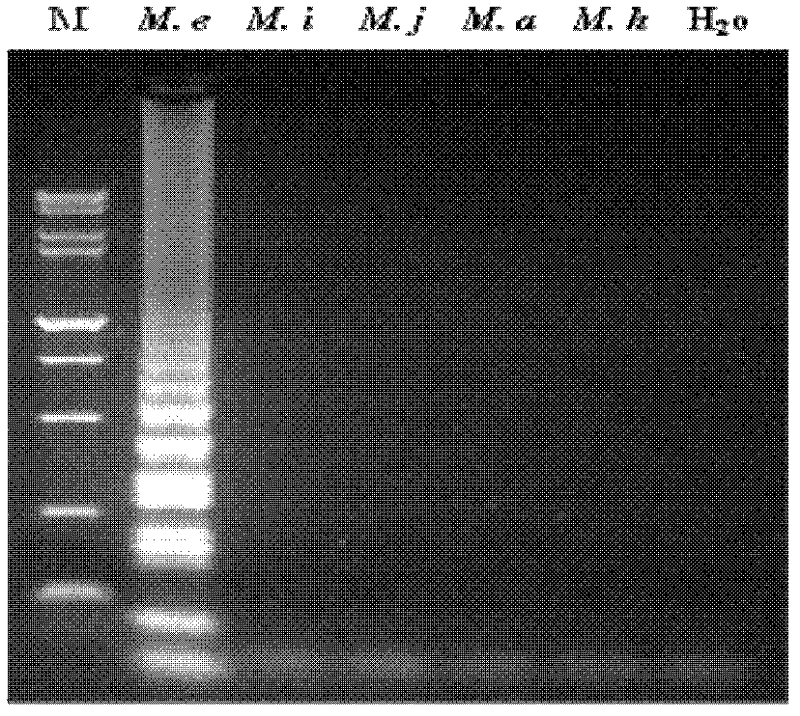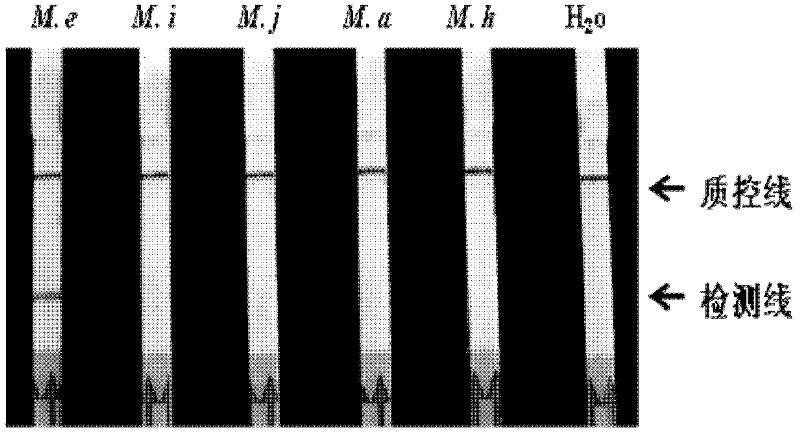A kit for the detection of root-knot nematode Elephant ear based on loop-mediated isothermal amplification and its application
A loop-mediated isothermal, root-knot nematode technology, applied in the determination/inspection of microorganisms, DNA/RNA fragments, recombinant DNA technology, etc., to avoid time loss, less technology dependence, and low cost
- Summary
- Abstract
- Description
- Claims
- Application Information
AI Technical Summary
Problems solved by technology
Method used
Image
Examples
Embodiment 1
[0048] Embodiment 1, the composition of kit
[0049] 1. Preparation of each component of the kit
[0050] 1. Preparation of primers
[0051] Specific oligonucleotide primers were designed according to the 5S rDNA gene and IGS2 region of Meloidogyne elegans, where there were polymorphic segments among species. A set of dedicated primers was synthesized, consisting of outer primers (Me-F3 and Me-B3, inner primers (Me-FIP: and Me-BIP) and loop primers (Me-LP and Me-BP).
[0052] Me-F3: 5'-CCAAGTACTAAGGAAGCCC-3' (sequence 1 of the sequence listing);
[0053] Me-B3: 5'-ATCCTAATTTTCCTCCCACACA-3' (sequence 2 of the sequence listing);
[0054] The 5' end Biotin mark of Me-FIP, nucleotide sequence is as follows (sequence 3 of sequence listing):
[0055] 5'-ACAGTGATTACGACCATACCGCGTTAACGTTGCTTAACTTGCCAGA-3';
[0056] Me-BIP: 5'-TCTAAGGCAAAGTGGGCGGAGCTCTTTTTGCCTTAAACCATTCCC-3' (SEQ ID NO: 4 of the Sequence Listing);
[0057] Me-LP: 5'-AAGCACGCCATCCCGTC-3' (sequence 5 of the sequence...
Embodiment 2
[0097] Embodiment 2, the application of kit
Embodiment 3
[0117] Embodiment 3, the sensitivity detection of kit
[0118] 1. A small amount of genomic DNA extraction
[0119] 1. Collect freshly hatched 2nd instar root-knot nematode larvae, centrifuge and wash in a 1.5ml centrifuge tube to form 10-20 μL nematode pellet.
[0120] 2. Use tweezers to freeze the tube and pointed glass rod in liquid nitrogen for 30 seconds, and grind it into powder vigorously.
[0121] 3. Add 700 μL of DNA extraction buffer (containing 50 mM Tris-HCl, pH 7.5, 50 mmol / L NaCl, 5 mM EDTA, 0.5% SDS) and 7 μL of 20 mg / mL proteinase K, and mix gently.
[0122] 4. Put the tube in a 50°C water bath for 4-5h.
[0123] 5. Next, extract once with equal volumes of Tris saturated phenol and chloroform / isoamyl alcohol, and centrifuge at 12,000 rpm for 10 min.
[0124]6. Take the supernatant into a new tube, add 0.1 times the volume of 3M NaAc (pH5.2) aqueous solution and 2.5 times the volume of pre-cooled absolute ethanol, and precipitate at -20°C for 20 minutes.
[...
PUM
 Login to View More
Login to View More Abstract
Description
Claims
Application Information
 Login to View More
Login to View More - R&D
- Intellectual Property
- Life Sciences
- Materials
- Tech Scout
- Unparalleled Data Quality
- Higher Quality Content
- 60% Fewer Hallucinations
Browse by: Latest US Patents, China's latest patents, Technical Efficacy Thesaurus, Application Domain, Technology Topic, Popular Technical Reports.
© 2025 PatSnap. All rights reserved.Legal|Privacy policy|Modern Slavery Act Transparency Statement|Sitemap|About US| Contact US: help@patsnap.com



